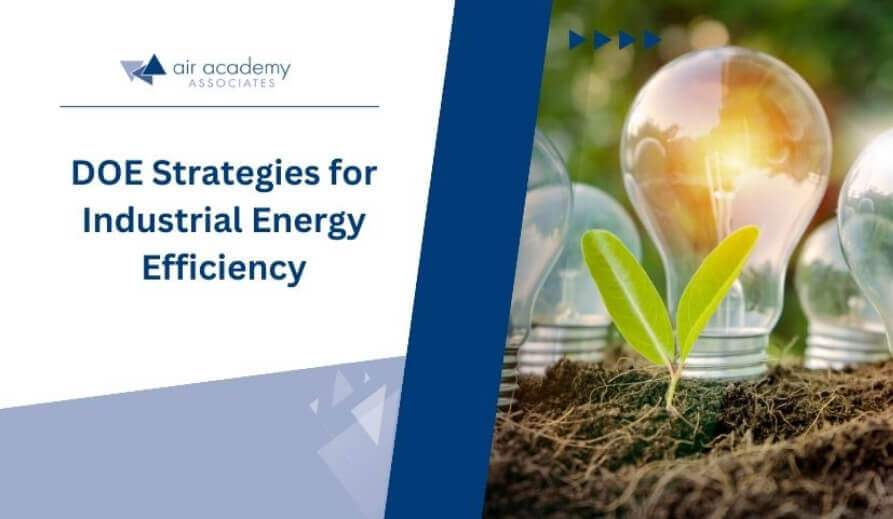
Energy efficiency is a critical objective in the industrial sector, as it supports economic and environmental sustainability. Utilizing the Design of Experiments (DOE) methodology offers a strategic method to improve this efficiency by systematically evaluating and optimizing energy consumption. By implementing DOE, industries can identify the essential factors that impact energy usage, enabling the implementation of data-driven strategies to decrease energy consumption without compromising productivity or quality.
Our blog will discuss how DOE can be effectively used in industrial settings to save a notable amount of energy. We will explore the principles of DOE and different methods and share real-life examples that highlight the positive impact of this approach on conserving energy. Our goal is to provide practical insights and showcase the transformative power of DOE in promoting greener and more efficient industrial practices.
Principles of DOE for Energy Efficiency

Image Source: Freepik
Implementing the Design of Experiments (DOE) in industrial energy efficiency programs requires a nuanced understanding of its principles and a structured approach to its application. The following discussion offers comprehensive guidelines to effectively apply DOE methodology, ensuring that industrial operations can maximize energy savings while maintaining or enhancing productivity.
Understanding DOE Principles
At its core, DOE involves a series of structured tests where input variables are systematically varied to observe and identify their effects on output variables. The primary aim is to understand the relationship between factors affecting a process and the results of that process, particularly in terms of energy consumption. Key principles include:
- Randomization: This principle ensures that the data collected are not biased by external factors, providing a true reflection of the effects of the tested variables.
- Replication: Repeating the experiment under the same conditions helps quantify the variability in the data, thereby increasing the reliability of the results.
- Blocking: By grouping similar experimental units, you can minimize the impact of variables not included in the study, thus isolating the effects of the variables of interest.
Applying DOE Methodologies
Several DOE methodologies are suitable for enhancing industrial energy efficiency, each with its specific application and benefits:
- Factorial Designs: These evaluate the effects of two or more factors by changing them simultaneously rather than one at a time. Factorial designs are especially useful in the initial stages of experimentation when the aim is to identify which factors are most significant.
- Response Surface Methods (RSM): RSM is used for optimizing processes. The goal is to find the best levels of process parameters that produce a response’s maximum or minimum value. It’s particularly effective when the relationship between the variables and the response is unknown.
- Taguchi Methods: Emphasizing the cost of variation and the loss imparted to society from deviating from target values, Taguchi methods are instrumental in making the process robust against variations, including energy usage.
Implementing DOE in Industrial Settings
To successfully implement DOE in industrial energy efficiency projects, consider the following steps:
- Objective Definition: Clearly define the experiment’s goals, including the specific energy efficiency improvements you aim to achieve.
- Variable Selection: Identify and select input variables that potentially influence energy consumption. These could include machine settings, material properties, or environmental conditions.
- Experiment Design: Choose an appropriate DOE design based on the identified objectives and variables. Consider the resources available, including time, materials, and computational tools.
- Data Collection and Analysis: Conduct the experiments according to the chosen design, collecting data meticulously. Use statistical software to analyze the results, focusing on identifying significant factors and their interactions.
- Optimization and Validation: Based on the analysis, propose adjustments to the process parameters to optimize energy efficiency. Conduct validation experiments to confirm that the proposed changes lead to the expected improvements.
DOE Methodologies in Action: Case Studies and Examples

Image Source: Pexels
The practical application of Design of Experiments (DOE) methodologies in enhancing industrial energy efficiency is best illustrated through case studies and examples. These real-world scenarios demonstrate the efficacy of DOE in identifying optimal operational parameters, leading to significant energy savings and process improvements.
Case Study 1: Manufacturing Process Optimization
DOE was applied in a manufacturing plant to optimize the energy consumption of a high-energy process. The factorial design methodology evaluated the effects of various operational parameters, including temperature settings, machine speed, and raw material characteristics. The objective was to minimize energy use while maintaining product quality.
The analysis revealed previously unknown significant interactions between temperature and machine speed. By adjusting these parameters based on the DOE findings, the plant achieved a 15% reduction in energy consumption for the process, translating to substantial cost savings and a lower carbon footprint.
Case Study 2: Reducing Energy in Chemical Production
A chemical company utilized the Response Surface Methodology (RSM) to explore the relationship between reaction conditions and energy efficiency in one of its key production processes. The goal was to identify conditions that would maximize the yield of the desired product while minimizing energy input.
The DOE study led to the discovery of an optimal combination of temperature and pressure that increased yield by 10% and reduced energy usage by 20%. This optimization enhanced the process’s energy efficiency and increased production capacity, offering the company a competitive advantage.
Case Study 3: Implementation of Taguchi Methods in Energy Management
An automotive parts manufacturer applied Taguchi methods to reduce the energy consumption of its painting process. The focus was on minimizing variation in energy usage while maintaining high-quality paint application. Factors considered included paint viscosity, spray pressure, and conveyor speed.
The optimization effort, guided by Taguchi’s robust design principles, resulted in a standardized process that reduced energy consumption by 25% without compromising the finish quality of the parts. Additionally, the process became less sensitive to external variables, ensuring consistent energy savings over time.
Implementation Guidelines from Case Studies
These case studies underscore the versatility and power of DOE in various industrial contexts. The following guidelines can be distilled from these examples for successful DOE implementation:
- Comprehensive Planning: Start with a clear understanding of the problem and objectives. Comprehensive planning ensures that the DOE is focused and relevant.
- Appropriate Design Selection: Choose a DOE design that fits the study process’s complexity and nature. Factorial designs are suitable for screening purposes, RSM for optimization, and Taguchi methods for robustness.
- Detailed Analysis: Utilize statistical analysis software to interpret the results accurately. Look beyond obvious factors to identify interactions and nonlinear effects.
- Iterative Optimization: Use the initial findings to refine the experiment. DOE is often an iterative process, with each cycle bringing closer to the optimal settings.
- Validation and Replication: To generalize the results, validate the findings with follow-up experiments and replicate the study in similar settings.
Future Trends in Industrial Energy Efficiency Through DOE

Image Source: Pexels
As industries worldwide transition towards more sustainable and energy-efficient operations, the strategic application of Design of Experiments (DOE) is set to play a pivotal role. With its roots in statistical analysis, this methodology offers a robust framework for optimizing processes, reducing waste, and significantly lowering energy consumption. By systematically exploring the effects of multiple variables on energy efficiency, DOE enables industries to identify the most effective energy conservation and sustainability strategies. Strategies
Embracing Policy-Driven Innovation and Investment
The global push towards energy efficiency, highlighted by the IEA, underscores the importance of innovation and investment in driving the energy transition. While policies and investments are rapidly evolving to support renewable energy sources and efficiency improvements, the application of DOE within these initiatives can maximize outcomes.
By integrating DOE in developing and refining energy-efficient technologies—such as heat pumps and electric vehicles—industries can better understand the dynamics of energy use and optimize product performance for maximum efficiency.
Overcoming Challenges with Advanced DOE Techniques
Targeted DOE studies can address the challenges and bottlenecks identified in transitioning to a more energy-efficient future, such as infrastructure needs, investment requirements, and material availability.
For instance, DOE can help evaluate the effectiveness of various configurations of renewable energy systems or assess the impact of different materials on the efficiency of green technologies. Industries can navigate these complexities by employing DOE, and identifying technically feasible, economically viable, and scalablesolutions.
DOE and the Shift Towards Renewable Energy
As renewables are set to make up a significant portion of the power mix by 2050, DOE methodologies can contribute to optimizing the integration and utilization of these energy sources in industrial operations.
By analyzing how different operational parameters affect energy consumption and efficiency in solar and wind power applications, DOE can aid in the design of more efficient renewable energy systems. This analytical approach ensures that industries can leverage renewable energy most effectively, contributing to overall energy efficiency and sustainability goals.
Conclusion
The global focus on policy-driven innovation, investment in green technologies, and DOE’s pivotal role in navigating the transition towards renewable energy underscore the importance of a systematic approach to energy efficiency. As industries adapt to the evolving energy landscape, characterized by a push towards renewables and the need for efficient energy management, DOE emerges as a critical tool in realizing these goals.
Leveraging DOE not only helps in overcoming operational challenges but also aligns industrial practices with global sustainability objectives. By continuously applying DOE to refine processes and technologies, industries can contribute significantly to reducing carbon emissions, conserving energy, and fostering a more sustainable future.
As we progress, the strategic application of DOE in industrial energy efficiency efforts will be essential in driving innovation, enhancing competitiveness, and achieving environmental stewardship.
At Air Academy Associates, we’re committed to empowering professionals with the skills to significantly enhance industrial energy efficiency through our Operational Design of Experiments Course. This comprehensive course, structured into 16 modules, will equip you with the knowledge to plan, design, conduct, and analyze experiments effectively, maximizing learning while minimizing resources. Whether you aim to identify crucial factors, optimize performance, or validate systems, our course offers the flexibility and capability to become proficient in DOE.


